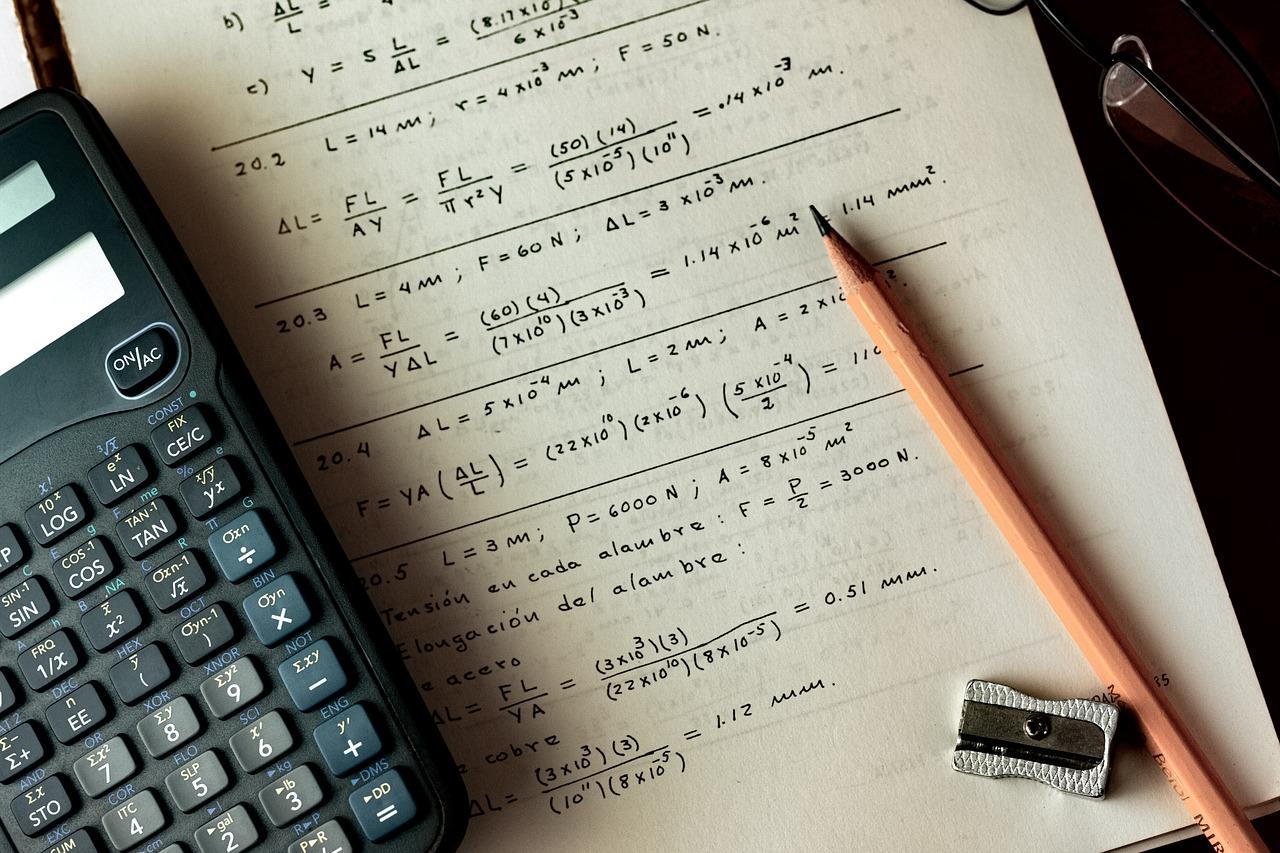Math is viewed as a subject where students can score well in school. Scoring well in maths exams demands significant dedication and hard work from students. Math exams can be nerve-wracking, and many students experience math anxiety before an exam. Adequate preparation and commitment can assist in achieving good grades in maths.
However, even with dedicated preparation, maths anxiety can affect students' memory, causing forgetfulness during exams. Overcoming the fear of maths is crucial to scoring well in the subject. Giving in to fear can weaken performance, resulting in lower scores on maths exams.
In order to have a calm mind during an exam, students must be well-prepared for the exam. Furthermore, students should sleep early on the day before and arrive at the exam venue early.
STPM Maths is a challenging examination that requires a comprehensive understanding of mathematical concepts and the ability to apply them to solve complex problems. However, with the right approach and strategies, it is possible to excel in this exam.

Overview of the Management Mathematics STPM Syllabus
Management Mathematics STPM is a pre-university module designed by the Malaysian Examinations Council. It aims to build strong foundations in mathematical reasoning and its applications within social sciences and management disciplines. The syllabus is delivered across three terms, each focusing on different themes that guide candidates toward exam readiness. If you’re interested in the broader pathway, you may also find it helpful to explore more about STPM in detail.
Key Components
Here are the main sections students will encounter within this syllabus:
Term One: Algebra and Calculus
Students explore functions, including domain, range, and inverse, and learn to sketch simple graphs. They also study polynomial and rational expressions, solving equations and handling partial fractions. Additionally, they tackle exponential and logarithmic expressions and their equations.
Term Two: Statistics
This section centres on probability and statistical distributions, including discrete and continuous types. Learners are guided through estimation techniques, hypothesis testing, correlation, and regression, tools essential for interpreting data in management contexts.
Term Three: Financial and Decision Mathematics
Students engage with topics such as annuities, investment appraisal, and life insurance — focusing on real-world financial decisions. They also study linear programming, critical path analysis and inventory control, which form the toolkit for operational planning and management decision-making.
Explanation of Structure and Focus
| Term | Focus Areas | Key Topics |
|---|---|---|
| Term One | Building foundational techniques | Functions, sequence & series, matrices & systems of linear equations, limits & continuity, differentiation, integration |
| Term Two | Introducing statistical tools for analysis | Probability, discrete & continuous distributions, estimation theory, hypothesis testing, correlation & regression |
| Term Three | Applying maths in real-world decision-making | Annuities, investment appraisals, life insurance, linear programming, critical path analysis, inventory control |
The syllabus progresses from foundational functions and equations in algebra toward practical applications such as linear programming and financial mathematics. Each chapter builds upon the previous term’s concepts, ensuring cohesion. For instance, understanding matrices and solving systems of linear equations supports later modules in optimisation and decision methods. The focus remains on problem-solving, modelling, and strategic application — skills highly valued in both tertiary education and Malaysia’s evolving job market.
In summary, the Management Mathematics STPM syllabus offers a balanced blend of theoretical foundations and real-life management tools. Term One lays the groundwork with algebra and calculus, Term Two introduces statistical reasoning, and Term Three focuses on financial models and operations research. This structured progression equips Malaysian students with both mathematical rigour and practical insight, a valuable combination for future academic and career endeavours.

Best Study Plan for STPM Mathematics T Preparation
Preparing for STPM Mathematics T can feel demanding, especially since it is a subject that combines both theoretical knowledge and problem-solving applications. This paper is intended for students pursuing science and mathematics-related fields, and it is divided into three terms, each with distinct learning objectives. A balanced study plan is essential because it allows students to manage their workload effectively across the year while steadily building confidence in each chapter of the syllabus.
Key Steps in the Study Plan
Understand the Syllabus Thoroughly
Begin by reviewing the official syllabus from the Malaysian Examinations Council. Each chapter has specific outcomes, such as mastering functions, solving equations, and applying differentiation or integration techniques. By identifying the expected outcomes early, you can allocate study hours more efficiently to each section, preventing last-minute cramming.
Focus on Core Concepts First
Pay attention to the foundations such as linear algebra, trigonometry, and calculus. For example, working through MATRIX problems or finding an Inverse can appear abstract, but these are recurring ideas that support later topics. Mastering the basic form of a function and understanding how to plot its graph will help when questions require the interpretation of values and points on a line or diagram.
Practise Problem-Solving Regularly
Problem-solving is central to Mathematics T. Use past exam questions released by MPM to practise forming solutions to different types of problems. Check the marking schemes for expected answers and the distribution of marks, as this gives insight into how to present workings clearly. When a solution requires multiple steps, write each row systematically to avoid errors.
Apply a Topic-by-Topic Approach
Break revision into smaller units. For example, spend one week tackling a single chapter, such as integration techniques, before moving on to probability. This prevents confusion and allows steady progress. By the end of each term, you should have revised every topic at least once, leaving enough time for reinforcement before the exam posts.
Mathematics is one of the most popular STPM subjects, with enrolment figures showing a consistently high take-up among students pursuing science and technology streams. In fact, according to the Ministry of Education Malaysia, over 40% of STPM candidates register for Mathematics T each year, reflecting its importance for entry into local and international science-related degree programmes.
Make Use of Visual Tools
Many students benefit from sketching graphs or drawing a diagram to interpret problems. Visualising a function makes it easier to understand concepts like gradient, turning points, and asymptotes. Even non-graphic topics, such as number theory, can be supported with tables or charts that display numbers clearly.
Share Knowledge and Revise in Groups
Studying with peers allows you to share problem-solving methods and compare approaches. Sometimes, a classmate’s example or unique way of using formulas can clarify a concept that seemed difficult before. Group revision also provides the chance to test one another with questions and check answers collectively.
Stay Organised with Time Management
Develop a realistic timetable that balances study with rest. Allocate extra time to topics where you struggle, and revise regularly rather than relying on memorisation. The following approach can be helpful: dedicate two hours a day to mathematics, with one session focusing on theory and another on practice.
Seek Feedback from Teachers
Teachers can highlight common mistakes and remind you of the signs of incorrect working, such as mismatched values or missing steps in an equation. Submitting homework consistently also allows you to receive marks and constructive feedback early in the year, reducing stress closer to exams.
A strong study plan for STPM Mathematics T combines understanding the syllabus, systematic practice, and effective time management. Students should build confidence gradually, moving from core functions and equations toward complex problem-solving tasks. By staying organised, making use of visual aids like graphs, and using feedback from teachers, every student can approach the final exam with clarity and confidence. The goal is not only to secure better marks but also to gain lasting skills in logical reasoning and structured problem-solving, something that becomes even more achievable when applying thoughtful STPM revision techniques throughout the study journey.

Exam Strategies for STPM Mathematics M
The STPM Mathematics M subject is tailored to students interested in management, social sciences, and economics. It differs from Mathematics T because it focuses less on abstract theory and more on practical applications. A successful approach requires not only understanding the chapters in the syllabus but also developing strategies to apply this knowledge under exam conditions. Careful planning and practice can make a significant difference in the marks obtained.
Key Strategies for Success
Understand the Syllabus and Exam Format
Begin by reviewing each chapter in the official syllabus issued by the Malaysian Examinations Council. This ensures you know which section each topic belongs to and the weight it carries in the overall assessment. Some areas, such as linear programming or financial mathematics, demand more practice, while others may involve statistical interpretation. By being clear about the structure, you will know how much time to spend on every row of your revision timetable.
Practise Past Questions Effectively
Using past year papers is one of the most reliable strategies. Work through sample problems to understand how equations, functions, and applied problems are typically presented. Always check the official marking scheme to see what answers receive full credit. This process also trains you to present each solution in a structured form, which examiners expect.
Focus on Application of Knowledge
Many questions in Mathematics M require you to interpret real-world data and form solutions accordingly. For example, in linear programming, you may need to draw a graph and determine the optimal value from the feasible region. Always label each line, axis, and point clearly, as missing details may cost you important marks. Practising with a diagram can help reinforce these steps.
Use the official STPM Past Year Papers available through the Majlis Peperiksaan Malaysia website. These provide real examples of how functions and graphs are tested, along with the expected form of answers. Practising with authentic sources ensures you are not misled by inaccurate materials circulating online.
Use Matrices in Problem-Solving
The MATRIX topic is especially useful when solving systems of equations or handling business-related data. Questions often require students to find the Inverse of a matrix and use it to obtain solutions. Be attentive to the signs and arrangement of numbers, because a single error in one row may affect the final value. A good strategy is to practise these problems repeatedly until you can work through them quickly and accurately.
Time Management During the Exam
Divide your time wisely across different sections of the paper. Some questions may appear longer but carry the same marks as shorter ones. Allocate time to ensure you reach the end of the paper without leaving blanks. A helpful method is to attempt questions you are confident in first, then return to more challenging examples later. This ensures you secure guaranteed marks before tackling complex solutions.
Check and Review Answers Carefully
The final minutes of the exam should be used for checking. Review each equation, verify that the values make sense, and confirm that your answers follow logically from the given information. Many students lose marks from small mistakes, such as misreading a sign or copying the wrong number. By training yourself to spot these details, you can save unnecessary loss of credit.
Collaborate and Share Study Methods
Before the exam, revise in small groups where you can share methods for solving questions. Sometimes a classmate’s example will show you a simpler way of using a formula or interpreting a problem. This kind of collaborative learning builds confidence and gives you exposure to unique approaches that may not appear in textbooks.
Preparing for STPM Mathematics M requires more than memorising formulas; it demands strategy, clarity, and practice. By focusing on the structure of the paper, applying knowledge to practical problems, and checking answers with care, you can approach the exam confidently. The emphasis should always be on clear presentation, correct use of functions and equations, and efficient time management.
Understanding the exam format and marking scheme can further guide your preparation, helping you prioritise topics and present solutions in a way that maximises marks. With discipline and effective revision, students can maximise their performance and achieve the marks needed for their chosen academic pathway.

Effective Study Strategies for STPM Mathematics
Preparing for STPM Mathematics requires consistent practice, clear planning, and the ability to understand concepts beyond memorisation. The subject builds on earlier chapters and expects students to apply knowledge in problem-solving contexts that are relevant to real-life situations. For Malaysian learners, the challenge is often not the complexity of the equations but the way the exam requires systematic approaches to arrive at correct solutions. By adopting a structured method, students can manage topics ranging from linear functions to more advanced areas such as MATRIX operations and the Inverse of functions.
Break Down Topics by Difficulty Level
Instead of tackling the syllabus randomly, divide each chapter into smaller parts and arrange them by level of difficulty. For example, if a line and graph topic feels easier, revise it first to build confidence before moving on to trigonometry or calculus. This ensures that every point of study time is maximised, while still covering the most challenging areas without feeling overwhelmed. According to reports by the Malaysian Examinations Council, this type of progressive learning helps students achieve better marks in the long term.
Use Diagrams to Strengthen Understanding
Many mathematical concepts are easier to grasp when converted into visual aids. Drawing a Diagram for a function, plotting values on a graph, or mapping rows in a MATRIX can make abstract concepts more concrete. Visualisation not only improves recall but also reduces errors, especially when interpreting Signs in statistical or probability-based questions. Using colour-coded diagrams can also SHARE knowledge effectively when revising with classmates.
Apply Real-World Examples
Students often understand better when they can relate a chapter to practical examples. For instance, a linear equation can be linked to budgeting expenses, where each value represents an item and the solution gives the total cost. Similarly, in business mathematics, the Inverse of a function can show how input and output numbers are related. These applications show the relevance of mathematics in everyday decisions and give added motivation to learn.
Focus on Accuracy Over Speed
While time is important, accuracy carries more marks than rushing through without proper answers. By carefully using each formula and checking every equation, students avoid losing points due to avoidable mistakes. The key is to strike a balance between speed and precision, especially when handling multiple sections in the exam paper. This habit also builds confidence during timed practice.
According to the Malaysian Examinations Council, past year STPM papers often include questions that combine more than one concept (for example, a function question that also requires interpreting a graph). Practising integrated questions helps students avoid confusion during the exam and ensures they can apply multiple methods to reach accurate solutions.
Keep a Record of Mistakes
Maintaining a record of past errors can highlight recurring patterns. Whether it was a missed sign, a miscalculated value, or an overlooked row in a MATRIX, writing them down allows students to revisit and correct them later. The Ministry of Education has highlighted in its guidance that reflective practice strengthens long-term retention. Keeping a “mistake log” at the end of each topic also provides a unique personal resource that can be reviewed before exams.
Learn to Interpret Questions Clearly
Sometimes the challenge lies not in solving the equation but in understanding what is being asked. Students should train themselves to read carefully, underline key numbers, and rephrase the question in their own words before starting. This reduces errors caused by misinterpretation and ensures the answers are directly linked to what was required. Treat each question as a short post or instruction that must be decoded logically before proceeding.
Stay Connected to Official Resources
In the following months leading to the exam, students should rely on official guidance from the Majlis Peperiksaan Malaysia. These resources often include model answers, exam forms, and marking schemes. Teachers can also be contacted through school platforms or even by email for clarification. Staying in touch with authentic resources ensures that the strategies used remain aligned with the real expectations of the exam board.
Boost Learning with Superprof
Alongside self-study, having guidance from an experienced tutor can make a significant difference in tackling complex chapters. Superprof is a global tutoring platform with more than 29 million teachers across 50+ countries, offering support in mathematics and many other subjects. Every tutor provides the first class free, making it easy for students to explore different teaching styles before committing. The platform is highly transparent about pricing and offers a wide choice of tutors who can provide personalised explanations, worked examples, and strategies tailored to the STPM syllabus. Students preparing for Mathematics in Malaysia are strongly encouraged to check out tutors on Superprof, as it can greatly strengthen understanding and confidence ahead of exams.
Effective strategies for STPM Mathematics go beyond memorising formulas. By using diagrams, applying real-life examples, maintaining a record of errors, and focusing on accuracy, students can strengthen both their understanding and performance. Mathematics is not just about abstract numbers but about finding meaningful solutions through structured thinking. For those looking to enhance their preparation, you can read our guide on amazing resources for STPM revision, which will help you access credible materials and optimise your study sessions. With steady practice and reliance on credible guidance, Malaysian students can approach the subject with greater confidence and clarity.
















